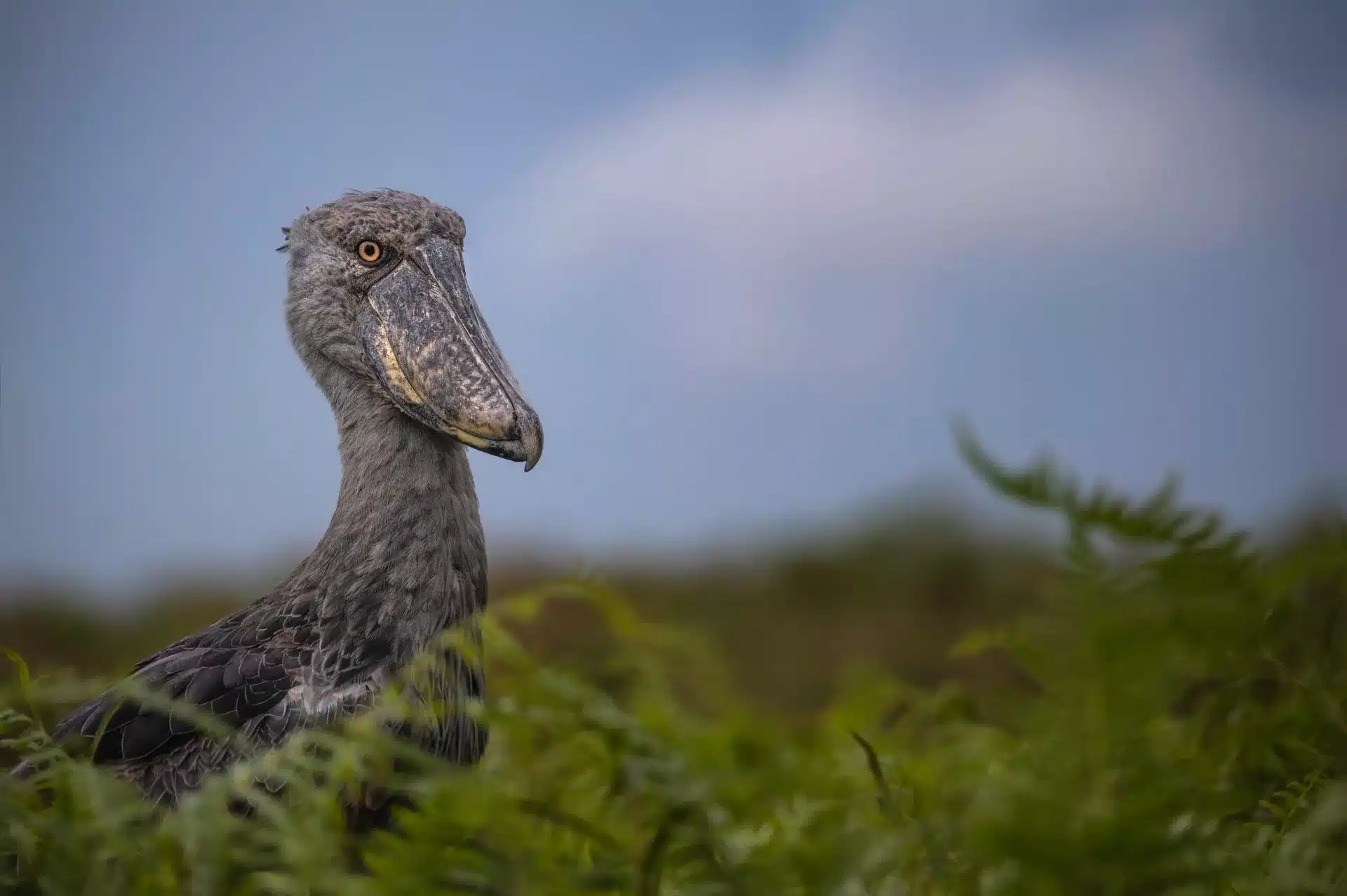Going bird watching in Uganda is like stepping into a living, breathing aviary. But it’s important to know where to go to see the best birds.
Mabamba Swamp, located on Lake Victoria’s shores in Entebbe, is renowned for its elusive shoebill stork and over 300 bird species. Beyond Mabamba, Uganda’s national parks, including Murchison Falls, Kibale Forest, Semuliki, Queen Elizabeth, Bwindi Impenetrable Forest, and Mgahinga, offer birdwatching experiences as diverse as the country’s landscapes.
Each park hosts a unique set of species, from savannah birds in Murchison Falls to forest endemics in Kibale and Albertine Rift endemics in Bwindi and Mgahinga.
Here’s a breakdown of the best places to go bird-watching in Uganda.
Top Places for Bird Watching in Uganda
Uganda stands out as a top birdwatching destination, showcasing a wide range of habitats and species.
Related: How Much Does a Uganda Safari Cost?
Mabamba Swamp
Mabamba swamp is located on the shorelines of Lake Victoria in Entebbe. Entebbe is the starting point of most safaris in Uganda, and birds always visit the Mabamba swamp found in Entebbe. Mabamba is famous for the Shoebill Stork, which is Uganda’s most sought after bird by bird watchers in the country.
More than 300 bird species have been recorded in Mabamba swamp so far. Bird-watching trips, which are done on motorized wooden boats through trails through the thick marshes, give birders opportunities to see some of the bird species recorded there. The best time to see the birds in Mabamba is in the morning, especially the shoebill stork.
Apart from the Shoebill, birders can see Papyrus Gonolek, Yellow-billed Duck, African Fish Eagle, Water Thick-knee, Grey Heron, Orange Weaver, Lesser Jacana, Goliath Heron, Black Crake, Woodland Kingfisher, Grey-crowned Crane, Hadada Ibis, Black Egret, Malachite Kingfisher, and Black-faced Rufous Warbler, among others.
Murchison Falls National Park
Over 541 bird species have been recorded so far in Murchison Falls National Park, making it one of the places you have to add to your birding areas on a Uganda safari. Bird watching in Murchison Falls National Park is carried out in places like Kaniyo Pabidi, the northern sector of the park, along the River Nile, and Royal Mile.
- Northern Banks: In the northern sector of Murchison Falls National Park, the predominant bird species are Savannah birds, such as Abyssinian Ground Hornbill, Black-billed Barbet, Rufous-crowned Roller, Superb Starling, African Darter, Long-toed Plover, Grey-crowned Crane, Hadada Ibis, African Open-billed Stork, Chestnut-capped Flycatcher, and Little Egret, among others.
- Kaniyo Pabidi: Bird watching in Kaniyo Pabidi, part of Budongo Forest, offers birders the chance to see forest birds such as Puvel’s Illadopsis and Yellow-footed Flycatcher, which are endemic to Budongo Forest. Other birds include Yellow-spotted Barbet, White-thighed Hornbill, Ituri Batis, Crested Guineafowl, and Little Greenbul, to mention but a few.
- Royal Mile: The Royal Mile is another captivating birding destination in Murchison Falls National Park, known for forest birds. Bird species found there include Puvel’s Illadopsis, Nahan’s Francolin, Yellow-footed Flycatcher, Fire-crested Alethe, Dusky Long-tailed Cuckoo, White-spotted Greenbul, Red-headed Malimbe, Lemon-bellied Crombec, Western Oriole, and White-thighed Hornbill.
- River Nile: Aquatic birds in Murchison Falls National Park can be observed along the River Nile. Birders can take a boat to the Nile Delta or to the bottom of the falls for a chance to see species like the Shoebill Stork, Papyrus Gonolek, Giant Kingfisher, African Darter, Giant Heron, Red-throated Bee-eater, and Veracious Dove, among others.

Kibale Forest National Park
Another famous birding destination in Uganda is the home to the highest population of chimpanzees in the world. The national park has over 370 bird species, which can be seen during guided forest walks and in areas like Bigodi Wetland Sanctuary.
Kibale Forest National Park is home to four bird species not recorded elsewhere in the country: Nahan’s Francolin, Cassin’s Spinetail, Masked Apalis, and Blue-headed Bee-eater. It is the premier location for sighting the highly sought-after African Pitta.
The birds of Kibale Forest National Park include the Green-breasted Pitta, Abyssinian Ground Thrush, Narina Trogon, Red-chested Owlet, Dusky Crimsonwing, African Shrike Flycatcher, Zebra Waxbill, Papyrus Canary, Black Bee-eater, African Emerald Cuckoo, Little Greenbul, Great Blue Turaco, Black-capped Waxbill, Great-throated Barbet, Olive Long-tailed Cuckoo, Afep Pigeon, and Little Sparrowhawk, among others.
Semuliki National Park
Semuliki National Park hosts approximately 441 bird species, including 23 Albertine Rift endemics. It stands out as one of the premier birdwatching destinations on a Uganda safari, offering unique opportunities such as spotting the rare Shoebill Stork during boat rides on Lake Albert.
Other notable birds in Semuliki include the Spot-breasted Ibis, Western Bronze-naped Pigeon, Red-thighed Sparrowhawk, Congo Serpent Eagle, Hartlaub’s Duck, Yellow-throated Cuckoo, Papyrus Gonolek, Long-tailed Hawk, Piping Hornbill, Black-throated Coucal, Nkulengu Rail, Icterine Greenbul, Swamp Palm Bulbul, and Northern Bearded Scrub Robin, among others.
Queen Elizabeth National Park
Queen Elizabeth National Park boasts the highest number of bird species among all national parks in the country. With over 600 bird species, the Park offers birders a variety of areas to spot them.
Birding spots include the Kasenyi area, Ishasha sector, Maramagambo Forest, Kazinga Channel, Katwe, Katunguru, Mweya Peninsula, and Lake Kikorongo area.
- Kazinga Channel: Birding on the Kazinga Channel is conducted on a boat cruise, allowing tourists to observe numerous aquatic bird species. Birds in the Kazinga Channel include the African Jacana, Martial Eagle, Shoebill Stork, Saddle-billed Stork, Malachite Kingfisher, Yellow-billed Stork, Goliath Heron, Lesser Flamingo, Great Blue Turaco, Long-crested Eagle, and Grey-crowned Crane, among others.
- Ishasha Sector: Birding in the Ishasha sector introduces birders to species such as the African Cuckoo, Black Bee-eater, African Wattled Plover, Brown Snake Eagle, Lappet-faced Vulture, African Green Pigeon, Grey-backed Fiscal, Black Coucal, Martial Eagle, African White-backed Vulture, Ross’s Turaco, and Senegal Plover, to name a few.
- Maramagambo Forest: Maramagambo Forest, located within Queen Elizabeth National Park, offers birdwatching opportunities. Over 190 bird species can be spotted. Examples include the African Green Pigeon, Verreaux’s Eagle, Purple-headed Starling, Rwenzori Turaco, Fawn-breasted Waxbill, Dark-capped Yellow Warbler, and Little Grebe.

Bwindi Impenetrable Forest National Park
Bwindi Impenetrable Forest National Park is home to over 350 bird species, 23 of which are Albertine Rift endemics. Bwindi is a prime destination for birdwatching in Uganda.
The best birding areas within the park include the Ruhija sector, Buhoma sector, and the Bwindi Neck.
- Buhoma Sector: Using birding trails such as the Munyaga River Trail, Muzabajiro Loop, and Habinyanja Trail, birders in the Buhoma Sector can observe species like the African Broadbill, Equatorial Akalat, Black-billed Turaco, African Green Broadbill, Great Blue Turaco, White-tailed Blue Flycatcher, Handsome Francolin, Rwenzori Turaco, Mountain Masked Apalis, Ansorge’s Greenbul, Western Nicator, and White-headed Barbet, among others.
- Ruhija Sector: In the Ruhija Sector, visiting areas like Mubwindi Swamp, Bamboo Trail, and Ruhija Hill will enable you to spot several bird species, including the Regal Sunbird, Rwenzori Apalis, Grauer’s Broadbill, Speckled Mousebird, Red-faced Barbet, Black Bee-eater, Zebra Waxbill, Kivu Ground Thrush, Black-billed Turaco, Montane Oriole, Shelley’s Crimsonwing, and Doherty’s Bushshrike, among others.
Mgahinga National Park
Mgahinga National Park is home to 180 bird species, 14 of which are endemic to the Albertine Rift region.
Notable bird species in Mgahinga include the Cinnamon Bracken Warbler, White-starred Robin, Rwenzori Turaco, Olive Pigeon, Double-collared Sunbird, Black Kite, Pin-tailed Whydah, Yellow-crowned Canary, Western Tinkerbird, Malachite Sunbird, Cape Robin-Chat, Yellow-billed Kite, and Hadada Ibis, among others.
When to do Birding in Uganda?
The optimal period for birdwatching in Uganda is during the dry seasons, spanning June to August and December to February. During these months, lower water levels create ideal feeding grounds, and shorter grass makes it easier to spot elusive species like the Shoebill without disturbance. However, the wet season, encompassing March, April, May, October, and November, attracts migratory birds due to the abundance of food.
While birding is a year-round activity in Uganda, it’s important to consider that some prime birding locations, such as Kibale Forest National Park and Bwindi Impenetrable Forest National Park, are situated in tropical rainforests where rain can be expected at any time. Visitors should come prepared with hiking boots, raincoats, long clothing, hand gloves, and other essentials for a comfortable experience.
Get in touch with Africa Adventure Vacations to book your birdwatching safari in Uganda. They will advise on the best time to visit and plan your entire safari for you!
Get your Binoculars Ready
Uganda’s rich tapestry of ecosystems, from the watery expanses of Mabamba Swamp to the diverse habitats of its national parks, positions it as a birdwatcher’s paradise. Each location offers a unique glimpse into the country’s abundant birdlife, including rare finds like the shoebill stork and numerous endemic species.
Whether you’re navigating the marshes of Mabamba or exploring the lush forests and savannahs of Uganda’s parks, the country promises an unforgettable birdwatching experience, cementing its status as a must-visit destination for bird enthusiasts around the globe.




